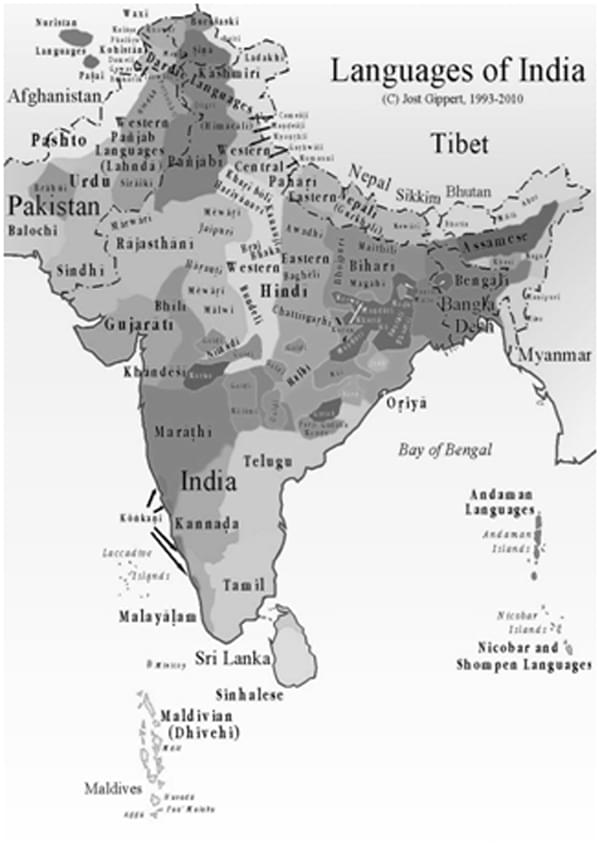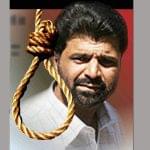Ethnic and Linguistic Minority
Linguistic Demography of India

Language is the only tool of culture, connectivity and identity. It is a powerful master trait for group identity and age old cultures. Therefore, language is essential for the survival of cultural communities.
Languages are also an important part of any educational curriculum. The Constitution of Indiarecognizes 22 major languages that are spoken by a large majority of the Indians. But there are hundreds of other languages and dialects that are spoken by the people in rural/tribal and far- fetched areas of the country. Also there are languages that connect people from the same caste, creed, background and region.
The spirit of “Indian Secularism” is the recognition and preservation of the different groups of people, with their diverse languages, ethnicity and beliefs. Article 29 and 30 of the Indian Constitution seek to preserve the differences that exist among the communities making India a pluralistic society, but at the same time, uniting them to form one strong nation.
The languages spoken in South-Asian Region belong to at least four major language families:
- Indo-European (most of which i.e. 74.24 percent speakers belong to its sub-branchIndo-Aryan)
- Dravidian (with 23.86 percent speakers)
- Austro-Asiatic (1.16% speakers )
- Sino-Tibetian (0.62% speakers)
These figures have been endorsed by both successive censusreports in India and the “Ethanologue” (Ethnologue: Languages of the World is a web-based publication that contains statistics for 7,105 languages and dialects in the 17th edition, released in 2013)
The, biggest chunkof languages and mother tongues belongtoIndo-Aryan sub-family of Indo-Europeanlanguages. Among the modern Indo-Aryanlanguages, Hindi and Bangla happen to bethe most well-known and widely spoken languages in India.
The westerndialect of the Hindi language is a midland Indo-Aryan language,spoken in the Gangetic plain and in the regionimmediately to its north and south. Aroundit, on three sides are Punjabi, Gujarati andRajasthani.
The Eastern dialect of the Hindi language is spoken inOudh and to its South. In the outer layer, there are languages such as Kashmiri, Lahnda,Sindhi, Gujarati, Marathi spoken in the northern and Western regions whereas Oriya, Maithili, Bengaliand Assamese are spoken in the East.
The Indian Constitution does notdefine or use the word minor or minoritylanguages, (although there is a mention oflinguistic minority), as per Census of India–1961, different categories of languagesdocumented in the country are listed below:
As against this, 1990-91 Census lists 216 mothertongues with a total number of speakers 10,000 or more at all India level, grouped into114 languages of which 22 mentioned in the Constitution are called scheduled languages.
The distribution of these languages is at oncediverse, complex and unequal.
Status of Linguistic Minorities in the Indian States
| S.No. | Name of the State/UT | Main Language | Minority Language |
|---|---|---|---|
| 1. | Arunachal Pradesh | Hindi, Assamese, Adi, Apatani, Bhoti, Champati and Nishi | State Government claims that there no language has been recognised as a minority language |
| 2. | Andaman & Nicobar | Hindi | Bengali, Tamil, Telugu, Malayalam, Nicobari, Kurukh/Oraon |
| 3. | Assam | Assamese | Bengali, Sadri, Hindi, Manipuri, Mishing, Karbi, Garo, Bodo, Nepali, Hmar |
| 4. | Andhra Pradesh | Telugu | Urdu, Hindi, Oriya |
| 5. | Orissa | Oriya | Urdu, Hindi, Oriya, Tamil, Kannad, Marathi |
| 6. | U.P | Hindi | Urdu, Punjabi, Sindhi |
| 7. | Uttarakhand | Hindi | Urdu, Punjabi, Nepali |
| 8. | Karnataka | Kannad | Urdu, Telugu, Tamil, Malayalam, Marathi, Tulu, Lamani, Hindi, Konkani and Gujarati |
| 9. | Kerala | Malayalam | Tamil, Kannad, Konkani |
| 10. | Gujarat | Gujarati | Hindi, Marathi, Sindhi, Urdu, Telugu, Malayalam, Oriya, Tamil |
| 11. | Goa | Konkani | Marathi, Hindi, Kannad, Urdu, Malayalam |
| 12. | Chhattisgarh | Hindi | Bengali, Oriya, Telugu, Marathi, Gondi, Kurukh, Halabi, Urdu |
| 13. | Jammu and Kashmir | Dogri, Kashmiri | Urdu, Hindi, Punjabi, Ladakhi, Balti |
| 14. | Jharkhand | Hindi | Bengali, Urdu, Santhali, Kharia, Mundari, Ho, Kurukh, Oriya, Kurmali, Khortha |
| 15. | Tamil Nadu | Tamil | Telugu, Kannad, Urdu, Malayalam, Hindi, Gujarati |
| 16. | Tripura | Bengali | Hindi, Kokborok, Chakma, Mogh, Halam, Manipuri, Vishnu Priya Manipuri |
| 17. | West Bengal | Bengali | Hindi, Santhali, Urdu, Nepali, Oriya, Telugu |
| 18. | Punjab | Punjabi, Hindi | Urdu |
| 19. | Bihar | Hindi | Urdu, Bengali |
| 20. | M.P | Hindi | Bhili/Bhilodi,Gondi,Marathi, Urdu, Oriya |
| 21. | Manipur | Manipuri | Thado, Paite, Tongkhul, Hmar, Mizo, Hindi, Nepali, Mao, Kuki, Bengali |
| 22. | Maharashtra | Marathi | Urdu, Hindi, Gujarati, Kannad, Telugu, Bhili, Khandeshi |
| 23. | Mizoram | Mizo | Bengali, Tripuri, Nepali, Hindi, Hmar, Pawai, Chakma |
| 24. | Meghalaya | Garo, Khasi | Assamese, Bengali, Hindi, Hajong, Nepali, Koch, Rabha, Sinteng |
| 25. | Rajasthan | Hindi | Urdu, Punjabi, Sindhi, Gujarati, Bhili/Bhilodi |
| 26. | Sikkim | Nepali | Lepcha,Limbu,Bhotia,Hindi, Sherpa, Tamang, Newari, Gureng |
| 27. | Haryana | Hindi | Punjabi and Urdu |
| 28. | Himachal Pradesh | Hindi | Lahuli, Bhoti, Punjabi, Kinnauri |
| 29. | Chandigarh | Hindi | Punjabi |
| 30. | Daman & Diu | Gujarati | Hindi, Marathi |
| 31. | Dadra & Nagar . Haveli | Gujrati, Konkani | Hindi, Marathi |
| 32. | Delhi | Hindi | Punjabi, Urdu, Sindhi, Telugu, Tamil, Bengali |
| 33. | Nagaland | Ao | Angami, Kuki, Lotha, Sema, Chokri, Konya |
| 34. | Pudducherry | Tamil, Hindi | Malayalam, French, Arabic, Telugu, Sanskrit |
| 35. | Lakshadweep | Malayalam, Mahl |
Source: 42nd Report of the Commissioner Linguistic Minorities (2003-2004)
Some States irrespective of their sizes havemore languages than others.Eg: The seven sisters of North EastIndia. In fact all theStates of India have linguistic minoritiesand all languages are minority languagesin some States or the other andare of different typesand according to the degrees of theirimportance.
The Census of 1990-91 has limited itself to only those languages and/or variants that are spoken by 10000 or more in India and thus,has left out many languages and its variants out of reckoning. There are some languages that are spoken by small number of speakers and for them this is the only language they know. Since, Article 350 A of the Constitution does not distinguish between the languages spoken by less than 10000 persons and more than 10000 persons, the decision of the Censusto retain 10000 speakers as the benchmark is a deviation from the Constitution.
For example, in Mini coy Island of Lakshdweep,almost all persons speak Mahal though the entire population of Minicoy Island is lessthan 10000 or so are the number of speakers. Mahal, though distinct from all other languages in the region, does not find a mention in the Census report.
Linguistic Profile of the States andUnion Territories – Important Statistics
The Indian Union consists of 29 States and 7 Union Territories with a population of approximately more than 1.25 billion (Census 2011). Language Census has been a part of Indian Census and Census 1991and lists 216 mother tongues with a total number of speakers of 10000 or more at all India level grouped into 114 languages. The question of Re-Organization of States of the Indian Union on linguistic basis led to the appointment of States’ Reorganization Commission. Based on the report of this Commission, a number of uni lingual States were formed in the year 1956. It seems the main motivating force behind this scheme of re-distribution of States’ territories was the idea of reducing the number of linguistic minorities by bringing people together who speak a common language. However, the reorganization of States on linguistic basis could not solve all the problems of linguistic minorities simply because different States are basically multi-lingual.
